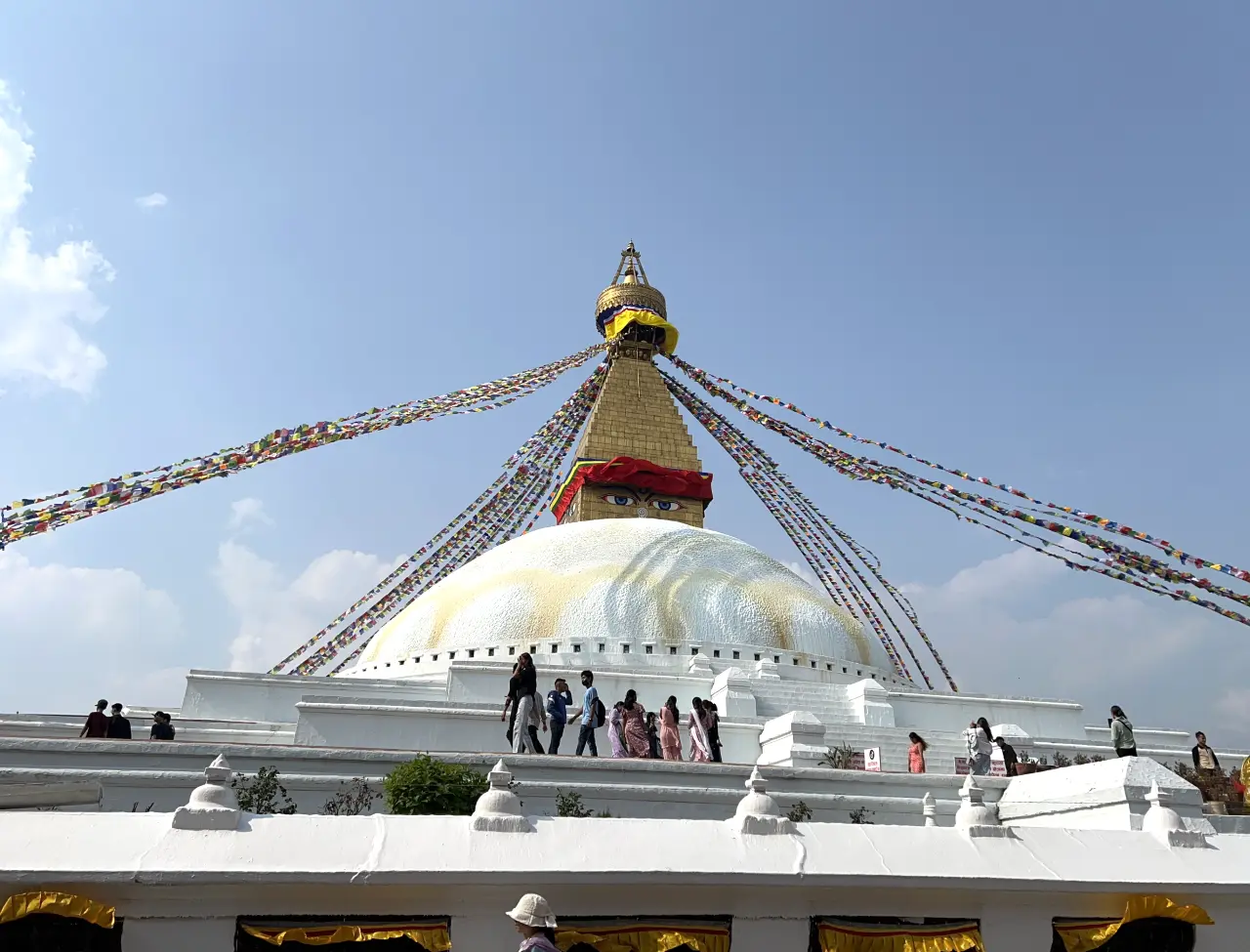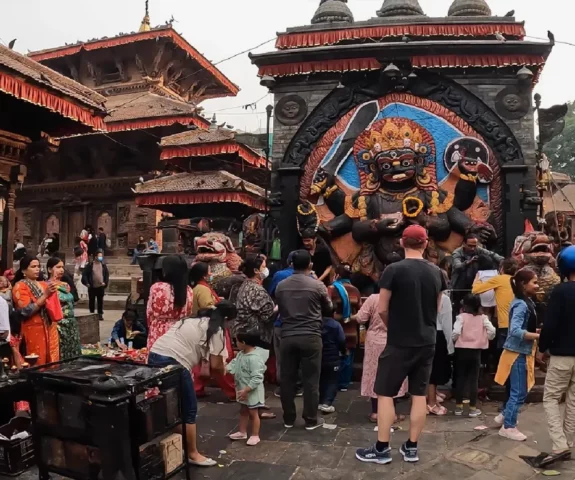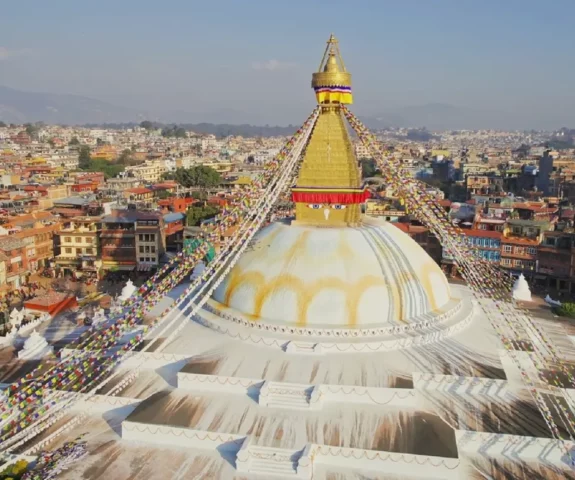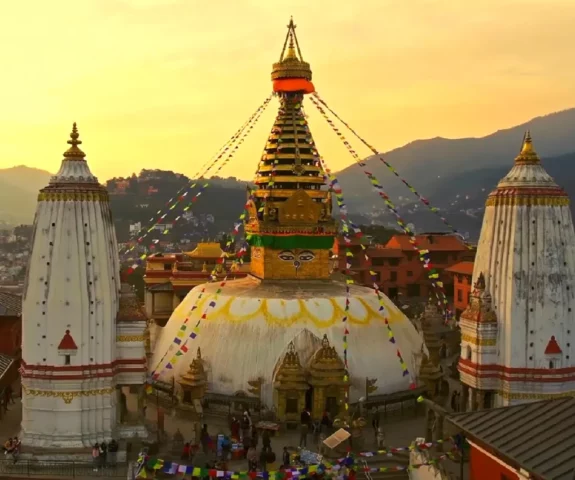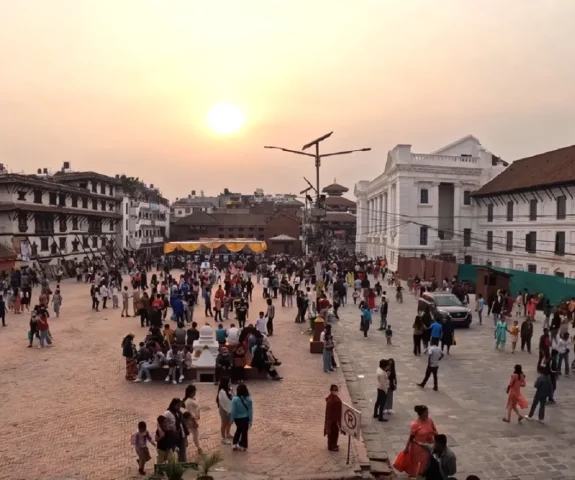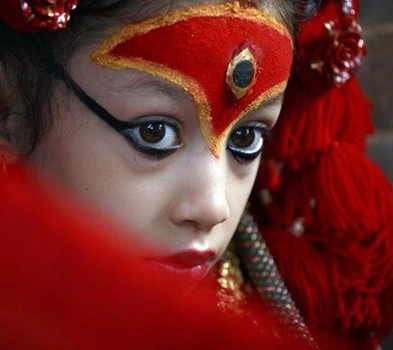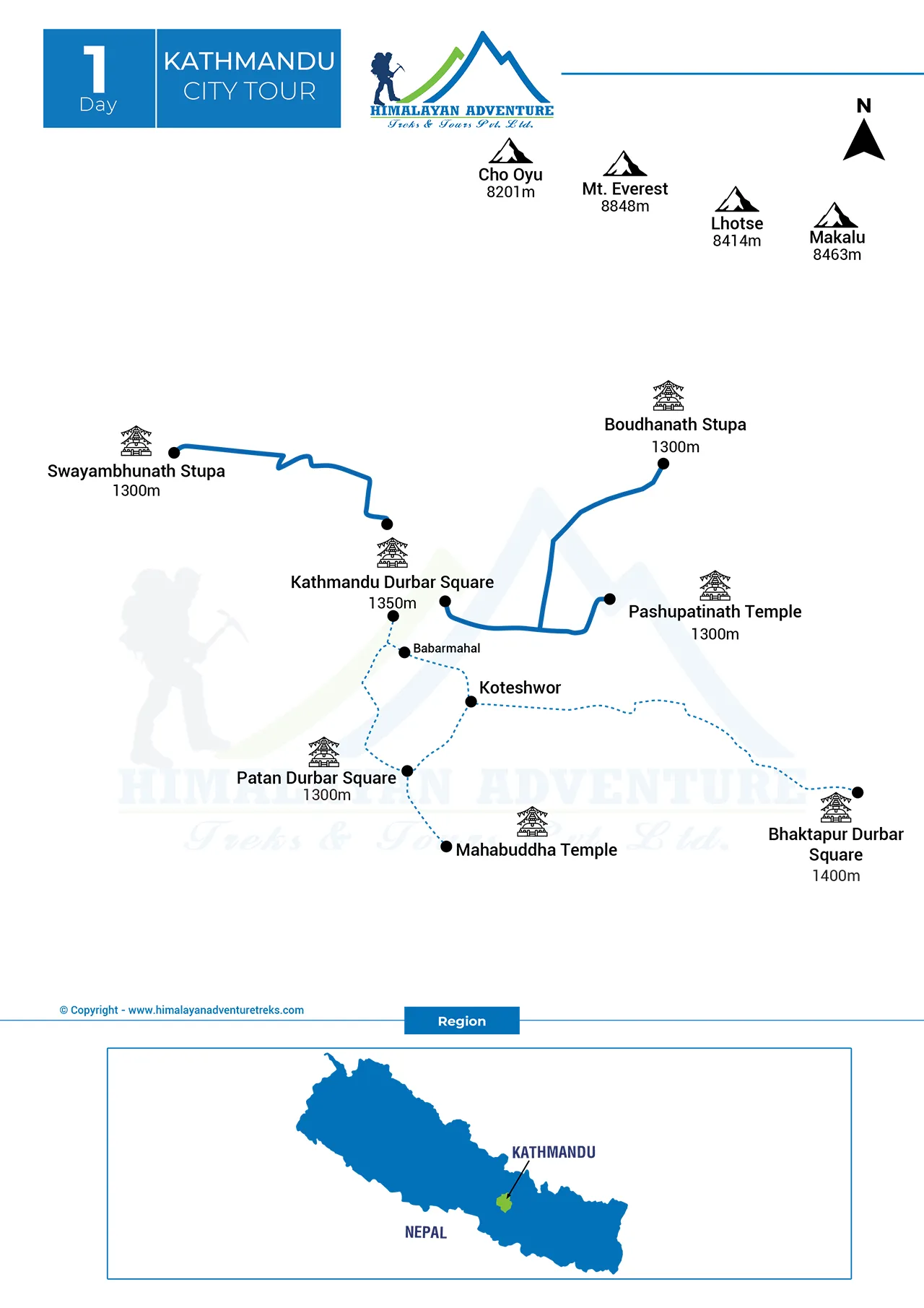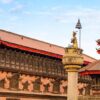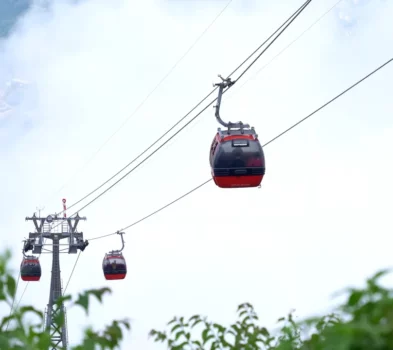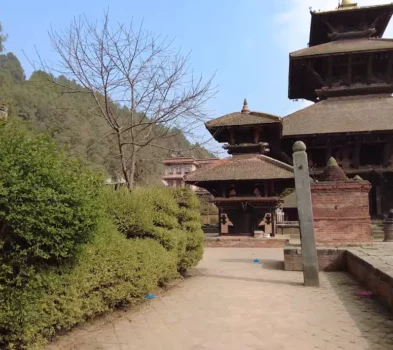Duration
5-6 hoursKathmandu City Tour
Trip Grade
EasyGroup Size
1-16 PeopleMax Altitude
1,400m. / 4,593ft.Best Season
Feb- May/ Sept- NovActivity
Day TourTransportation
Private VehicleTrip Customization
On request (click here)Highlights of Kathmandu City Tour
- Visit the world heritage sites inside Kathmandu valley.
- Observe the culture, tradition, and architecture of ancient Kathmandu.
- Learn about the history of Nepal and Kathmandu valley.
Trip Introduction
Kathmandu is one of the oldest cities in Nepal and is home to much of the cultural heritage. This tour takes you to the well-known world heritage sites inside the valley. Kathmandu Day Tour takes a day to complete and offers insight into the history and culture of Kathmandu. In addition, you can also observe the lifestyle of the people in the valley.
Firstly, the day starts with breakfast in the morning at 8.30 am. Then, you prepare for the tour and carry the necessary stuff. You leave the hotel with a guide at around 9 am and head to Swayambhunath, the Monkey Temple. It offers a grand insight into Buddhist art and culture. Further, you head to Pashupatinath, which is one of the holiest temples of Hindus and is dedicated to Lord Shiva. Furthermore, you drive to Boudhanath, which is another Buddhist pilgrimage site. The stupa area boasts a remarkable display of modern amenities and Buddhist heritage. Lastly, you visit Kathmandu Durbar Square and stroll around the palace courtyards. Here, you enjoy the art and architecture of medieval Kathmandu. Lastly, you drive back to the hotel and end the tour.
You can do the Kathmandu Day Tour all around the year. However, the monsoon season can be a bit troublesome because of the heavy rainfall. Also, you can avoid summer because traveling may be hard due to the heat. People of any age group can enjoy this tour as it is easy, and you can pick any other tour package in addition to this.
At Himalayan Adventure Treks, we take care of all the important things you need on this tour. We provide you with the finest travel services along with expert guides. Our company offers many other tours and travel packages as well.
Outline Itinerary of Kathmandu City Tour
Day 01: Explore 4 Heritages sites.
Our guests sharing their experiences (Photo/Video Gallery)
Detail itinerary of Kathmandu City Tour
Day 01: Explore 4 Heritages sites.
Pashupatinath Temple: It is a very large, complex, and focal point for the Hindu religion. This old and very revered complex of Temple and shrines is dedicated to Lord Shiva, one of the main deities of Hinduism and very popular in Nepal as well as Indian devotees. Hindu people believe that Lord Shiva has multiple forms he is often seen as the destroyer god.
This has great significance for the Pashupatinath temple as it is the site of many Hindu ritual cremations each day on the bank of the holy Bagmati River. Pashupatinath Temple is considered by Hindus to be an auspicious site for passing from one stage of life to the next through the purifying and destroying flames of cremation on the bank of Bagmati river and feet of Lord Shiva called Brahmanal.
However, on a happier note, visitors may also get to see the temple in a buoyant festival mode with one of the many Hindu festivals like Shivaratri, Teej, Janaipurinma and many celebrated here throughout the year.
Boudhanath Stupa: It is a Buddhist religious complex with a long history back over 500 years and more. which is also the World Heritage Site UNESCO. Located on the eastern part of Kathmandu valley it is now a site of great pilgrimage for Buddhist followers who circle its massive stupa, spin its many prayer wheels and visit its beautiful monastery.
The main feature of Boudhanath is its huge hemispherical white stupa with a central golden tower and the all-seeing eyes of the Buddha. It also believes that eyes represent peace and love. Visitors should circle the stupa in a clockwise direction and spin prayer wheels for good fortune and get Nirvana.
Boudhanath surrounding is a kind of school for the visitors who are interested in Thangka painting to see highly skilled artists at work on religious mandala paintings.
Kathmandu Durbar Square: It holds the places of the ancient king who ruled over the Kathmandu Kingdom. The durbar square is an ancient Malla king of the Kathmandu Valley. It is all of the arts and architectural treasures of a UNESCO World Heritage Site.
It is also called the Hanuman Dhoka in central Kathmandu. It believes that the Kasthamandap temple was build in the 5th century from a single tree. The durbar square has many beautiful multi-storey pagodas and temples with ornate carving and carpentry artwork that tells some of the stories of the ancient kings and their mystical times and beliefs.
The durbar square contains many important Hindu temples and statues such as Kal Bhairab, Swyat (White) Bhairb, and Lord Shiva. The main attraction for tourists contains unique and intriguing Kumari Chowk. This is an ancient and ornate house where resides in the Living Goddess.
The young girl has chosen through an ancient and mystical selection process from the Newar community to become the human incarnation of the Hindu mother goddess, Durga. At the Kumari courtyard the right time is in the afternoon you may see a brief glimpse of the Goddess at her window.
Swayambhunath (Monkey Temple): Swayambhunath stupa complex that sits atop a high hill overlooking Kathmandu and the entire Kathmandu Valley with Mountain ranges on the north side. Swayambhunath is probably the most sacred Buddhist pilgrimage site in Nepal.
It is another famous tourist destination and the holiest Buddhist and Hindu pilgrims. This temple also called the Monkey temple due to the lots of monkeys and they have their swimming pool. This is a wonderful place to catch your breath and observe the sunset, start to understand the deep importance of Buddhist belief to the people.
It consists of a huge white stupa with the all-seeing-eyes, it believes in the love and peace of Lord Buddha, and many small stupas and beautifully carved stone shrines on the top of the hill. If you feel more energetic then you might also like to try some or all of the 350 steps or more that lead all the way from the eastern part from the temple called Bhagwan pau (God Feet)up to your Swayambhunath stupa vantage point.
Activity: Tour, 5-6 hours
Max. Altitude: 1,400m/4,593ft. Kathmandu
Note:
If you have your own private group and want to make your trip private, we can run the custom trip all the day as per your requirements and group size.
Includes and Excludes
What are included with package?
- Experienced and Helpful Tour Guide: A knowledgeable and friendly tour guide will accompany you throughout the trip, offering valuable insights into the culture, history, and surroundings, ensuring a smooth and enjoyable experience.
- Transportation by Private Vehicle: Comfortable and private transportation will be provided for the tour, ensuring convenience and flexibility during transfers between locations.
What are not included with package?
- Lunch & Beverage Drinks: Meals and drinks consumed during the tour, apart from those provided in the package, are not included and will be at your own expense.
- Entrance Fee: The cost of entry to various attractions, temples, parks, and other sightseeing spots is typically not included in the package and will need to be paid separately.
- Any Kind of Personal Expenses: Personal expenses such as souvenirs, additional snacks, tips, phone calls, or any other out-of-pocket costs are not covered by the tour package.
Pick Your Suitable Date
Book a Private Trip
Private & Group Discount Price
-
1 -
1 person
US$ 120
-
2 -
2 people
US$ 100
-
3 -
5 people
US$ 80
-
6 -
10 people
US$ 60
-
11 + people
9999
US$ 50
Total Cost:
US$ 120
Route Map & Altitude Chart
Kathmandu Hotel
Start/End point
Kathmandu Hotel
Trip Information
Entrance fees of Heritage Sites of Nepal:
Nepal is famous for world heritage sites, Tourist attractions places, and monuments areas. Tourism is the second income source of the country. Entrance fees, National park fees, climbing royalties are the backbone of the Nepalese economy. Foreigner tourists visiting heritage sites, attraction places, and monuments of the country and have to pay a certain entrance fee to get inside the area. The people of South Asian countries (SAARC) have to pay fewer entrance fees in comparison to tourists from other countries. Many tourists want to see the typical Nepalese art and cultural places, happily paying the entrance fee because it is worth paying to visit.
The 7 heritage sites of Kathmandu valley are amazing. Boudhanath, Pashupatinath, Swayambhunath, Kathmandu Durbar Square, Patan Durbar Square, Bhaktapur Durbar Square, and Changunarayan have their own history. They are not only rich in art and architecture but also fountain spiritual places of Hinduism and Buddhism. Most of the constructions made have a tantric background and old history. Not only the Kathmandu valley but other parts of the country are also rich in nature and history. Lumbini (Birth Place of Gautam Buddha) Chitwan National park, Pokhara, Nagarkot, Trekking trails, Peak climbing, Expedition are the main tourist destination in Nepal and main income sources of the country. It is the government that keeps the price of priceless monuments and makes some money from tourists who visit them.
Please find the attached PDF file for the Entrance fees of World heritage and other attraction places in Nepal.
Entrance Fees of UNESCO World Heritage Sites in Nepal
About Country
Popularly recognized worldwide for its majestic sky-dominating peaks, Nepal is one of the most sought-after nations for trekking and other adventure activities. This tiny Himalayan nation is home to eight of the world’s tallest peaks, including Mt. Everest (8848.86m)- the highest mountain in the world. Moreover, the rugged and rural trekking trails to the massifs along the dense forest which is filled with exotic floras and faunas instills excitement and adventures to the travelers. However, traveling to Nepal is not only about the mountains and natural beauty. Unraveling the beauty that lies in the old monuments, palaces, and temples. Nepal has a diverse array of cultures, traditions, languages, and history which are reflected in the lifestyle of the people.
Key Facts
Location: Nepal is located in South Asia; between two great giants the Republic of China to the north and India to the south, east, and west.
Geography: A landlocked country, Nepal is divided into three geographical regions, namely, the Himalayas, the Hills, and the Terai.
Capital: The capital city of Nepal is Kathmandu.
Area: The total area of Nepal is 147,181sq km.
Population: The current population of Nepal is 29 million.
Political system: Nepal is a federal republic country with a multi-party system.
Major religion: Nepal is a secular state but the majority of people follow Hinduism, followed by Buddhism and Christianity.
Time zone: The time zone of Nepal is GMT +5:45.
Official Language: The official language of Nepal is Nepali.
Working hours: The working hours in Nepal are from 10 am to 5 pm.
Electricity: Currently, all the major cities have electricity while electricity supply in some rural areas is limited. The standard voltage of electricity in Nepal is 220V.
Visa Information
All tourists visiting Nepal except tourists from India should have a valid passport and visa. An On-Arrival visa to enter can be obtained at the Tribhuvan International Airport or any other land entry/exit points at the Nepal-Tibet and Nepal-India border. During the peak season, there will be a long line of tourists here trying to get their visas. So, to avoid the endless waiting you should visit the nearest Nepalese diplomatic missions stationed in your country before your arrival.
An On-Arrival Tourist Visa costs USD 30 for 15 days, USD 50 for 30 days, and USD 125 for 90 days.
You can also extend your visa within a valid period which will cost you USD 3 per day. However, if you are visiting Nepal from SAARC countries you don’t have to pay visa fees as gratis fee or free visa is applicable for 100 days. Regarding information about tourist visas, you can head to the information on the official website of the Department of Immigration at http://www.nepalimmigration.gov.np/page/tourist-visa.
How to reach the country
Nepal is very well accessible via air, rail, and road. Tribhuvan International Airport is the only international airport and the entry point for those arriving by air. Nepal Airlines is the main operator in the nation. Other international airlines here are Air Arabia, Air Asia, Etihad airlines, Fly Dubai, Jet Airways, Malaysia Airlines, Qatar Airways, Silk Air, and Thai air. The rail and road service can only be used by those arriving from India.
In terms of land transport, there are several land entry/exit points at the Nepal-Tibet and Nepal-India borders. Kerung and Kodari are the entry/exit points at the Nepal-Tibet border whereas
Janakpur-Jainagar railway is the sole railway that connects Nepal with India, several buses connect Delhi and Kathmandu.
Popular destinations to visit
There are many places you can visit in Nepal. Nepal is not only gifted with natural beauty but it is also culturally rich which means there are many heritages and sites you can visit. Kathmandu Valley is the first and foremost destination that you should not miss out on. The seven UNESCO world heritage sites in the valley, namely, Patan Durbar Square, Bhaktapur Durbar Square, Kathmandu Durbar Square, Pashupatinath, Swayambhunath, Boudhanath, and Changunarayan.
Other places you must visit while in Nepal are Pokhara, Chitwan, and Lumbini. Pokhara is a scenic lake city, located 6 hours’ drive away from Kathmandu city. There you will be able to enjoy the serene and peaceful nature with the Annapurna ranges in the backdrop. Lumbini, the birthplace of Lord Buddha, is a historic destination whereas the Chitwan National Park is a natural haven for exotic flora and fauna. Both of these are also enlisted as world heritage sites by UNESCO. Palpa, Bandipur, Bardia National Park, and Ilam are some of the popular destinations.
As for trekking and mountaineering activities, Annapurna, Everest, Langtang, Manaslu, Upper Mustang, and Dolpo regions are some of the most popular ones in Nepal.
Internet and Communication in the country
You do not have to worry about not getting communication service or Internet service in Nepal. In recent years, the internet and communication services have drastically progressed and developed. While in the major cities and tourist destinations, you can use free Wi-Fi including many of the cafes and restaurants. Similarly, almost every hotel and some public areas provide Wi-Fi services. However, Wi-Fi is not always available in remote areas in the Himalayas and rural Hilly regions.
In such situations, a cellular connection is the best option for both Internet access and communication. NTC and Ncell at two of the biggest telecommunication corporations and offer sim cards with various packages at a reasonable price. These service providers have a wide reach over many parts of Nepal. You will easily be able to purchase any sim card with your passport or identity card.
Local currency and foreign exchange
While in Nepal, you should use Nepali rupees (NRs) which is also the official currency of Nepal. You can easily exchange your currency into the Nepalese Rupee at the Tribhuvan International Airport or the exchange counters and banks around the major cities. Also, the major cities like Kathmandu, Pokhara, Chitwan, and Lumbini have a great availability of banks and ATMs. However, their availability becomes quite scarce when you head to the Himalayas and remote areas. So, it is best if the travelers perform all their money-related activities while they are in the major cities.
Weather and climate
The climate in Nepal varies according to altitude and the current season. The lowland of the Terai region in the southern part of the country is very hot and humid during the summer. The temperature there can get as high as 45 degrees Celsius. The middle part is also known as the hilly region has a pleasant and bearable climate all year long. However, in winter the nights and early mornings can get quite chilly. The Himalayan region is the northernmost part of the country and is above 3300m. This region usually has alpine climatic conditions and during the winter season, it experiences adverse weather conditions.
Nepal generally has four seasons, namely, spring, summer, autumn, and winter. The spring here means every part of the country has flowers blooming and summer means a lot of humidity and rainfall. While the autumn is neither too hot nor too cold and the skies are always clear. The winter season brings snow in the Himalayan region and some parts of the hilly region as well. Finally, during the monsoon season, the entire country experiences heavy rainfall except in the rain shadow areas of Upper Dolpo and Mustang.
People, culture, and festivals
Nepalese are known to be one of the kindest people all over the world. With a smile on everyone’s face, you will be warmly welcomed and greeted. The word “Namaste” is used while they join their hands together which means a respectful greeting. Nepal is a culturally rich country with many different castes, languages, and traditions. The diverse culture and tradition result in many different festivals celebrated all around the nation. The major festivals celebrated are Dashain, Tihar, Holi, Sonam Losar, Gyalpo Losar, and many more. Especially in Newari settlements, people celebrate many colorful and radiant festivals. You will be able to experience wonderful and lifelong memory if you visit Nepal during the time of festivals.
Frequently Asked Questions
What is the Kathmandu Day Tour?
The Kathmandu Day Tour is a full-day sightseeing experience that explores four major UNESCO World Heritage Sites in Kathmandu—Swayambhunath (Monkey Temple), Pashupatinath Temple, Boudhanath Stupa, and Kathmandu Durbar Square. It offers deep insights into Nepal’s culture, religion, and ancient architecture.
Which places are included in the Kathmandu Day Tour itinerary?
The tour includes a visit to Swayambhunath (Monkey Temple), a Buddhist pilgrimage site with panoramic views; Pashupatinath Temple, the most sacred Hindu temple of Lord Shiva; Boudhanath Stupa, one of the largest stupas in the world; and Kathmandu Durbar Square, the historic royal palace area of medieval Nepal.
How long does the Kathmandu Day Tour take?
The tour usually begins at 9:00 AM after breakfast and lasts until late afternoon, covering all major Kathmandu valley heritage sites in a single day. The duration may vary slightly based on traffic and personal pace at each location.
What is the best time of year to do the Kathmandu Day Tour?
The tour can be done year-round, but the best seasons are autumn (September to November) and spring (March to May) due to clear weather. It is advisable to avoid the monsoon (June to August) and peak summer heat for a more comfortable experience.
Is the Kathmandu Day Tour suitable for all age groups?
Yes, this is an easy and accessible tour suitable for travelers of all age groups, including seniors and children. There is minimal walking involved, and most sites are reachable by vehicle with some short walking around the temple or stupa complexes.
What should I bring for the Kathmandu Day Tour?
You should bring comfortable walking shoes, sun protection (hat, sunscreen), a refillable water bottle, a camera, and some local currency for entrance fees and personal expenses. Modest clothing is recommended for temple visits in Kathmandu.
Why is Swayambhunath known as the Monkey Temple?
Swayambhunath is nicknamed the Monkey Temple due to the large population of monkeys that inhabit the hill. It is one of the oldest Buddhist stupas in Nepal, offering spiritual ambiance, intricate carvings, and a panoramic view of the Kathmandu Valley.
What makes Pashupatinath Temple significant?
Pashupatinath Temple is one of the holiest Hindu temples in the world, dedicated to Lord Shiva. It’s a key part of Hindu pilgrimage tours in Nepal and also known for its cremation ghats along the Bagmati River, reflecting Nepalese spiritual traditions.
What can I expect at Boudhanath Stupa?
At Boudhanath Stupa, you’ll find a massive white dome surrounded by Tibetan Buddhist monasteries, prayer wheels, and colorful prayer flags. The area is peaceful and spiritual, ideal for understanding Tibetan Buddhism in Kathmandu and enjoying the serene atmosphere.
Is Kathmandu Durbar Square worth visiting?
Absolutely. Kathmandu Durbar Square is a treasure trove of Nepalese art, woodwork, temples, and palace architecture. You can explore Kumari Ghar (the Living Goddess), Hanuman Dhoka Palace, and various pagoda-style temples, making it a key highlight of any cultural heritage tour in Nepal.

